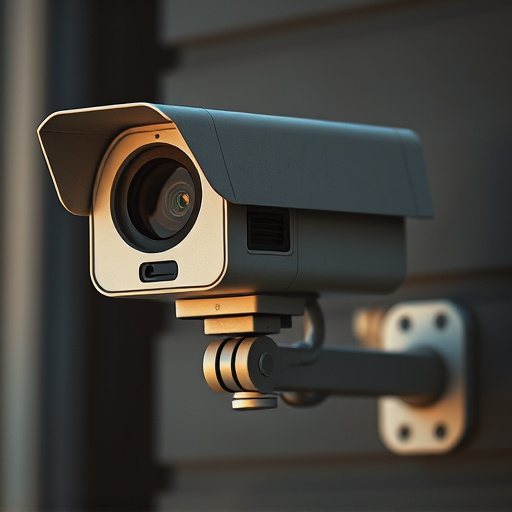Infrared (IR) LEDs in dummy security cameras are crucial for nighttime clarity and deterrence. Following the Dummy Security Camera Height Guidelines (5–8 feet or 1.5–2.4 meters) ensures optimal placement for clear, reliable footage. Strategic positioning at or slightly above eye level enhances surveillance effectiveness and serves as a deterrent to intruders. Regular cleaning prevents debris from blocking IR emitters, maintaining night vision performance.
In today’s digital age, enhancing home security is paramount. One effective yet often overlooked tool is the dummy security camera. This article delves into the world of fake camera infrared sensor LEDs, explaining their function and the reasons behind their widespread use. We’ll guide you through choosing the right height for these cameras according to Dummy Security Camera Height Guidelines, exploring benefits, and highlighting common mistakes to avoid for optimal protection.
- Understanding Fake Camera Infrared Sensor LEDs
- Why Dummy Security Cameras are Used
- Choosing the Right Height for Dummy Cameras
- Benefits of Using Dummy Security Cameras
- Common Mistakes to Avoid with Dummy Cameras
Understanding Fake Camera Infrared Sensor LEDs
Infrared (IR) sensors are a key component in many security cameras, enabling them to capture night-time footage with clarity. However, it’s essential to be aware of fake or inferior IR sensor LEDs that may be used in low-quality dummy security cameras. These counterfeit components can significantly impact the performance and reliability of your surveillance system.
When considering a dummy security camera, especially those designed for height guidelines, look beyond the aesthetics. Ensure the product specifies genuine IR LED technology, as this ensures optimal performance. Fake sensors might produce inconsistent infrared illumination, leading to poor image quality or even complete darkness in low-light conditions. Following the correct Dummy Security Camera Height Guidelines is crucial, but selecting a reliable product with authentic parts guarantees the system will function as intended, providing clear and consistent surveillance around the clock.
Why Dummy Security Cameras are Used
Dummy security cameras, also known as mock or fake cameras, are an effective deterrence measure for crime prevention. Their primary purpose is to trick potential intruders into believing that a property is under constant surveillance, even when no actual recording is taking place. These cameras are particularly useful in residential and commercial settings where real security systems might be expensive to install or maintain.
The strategic placement of dummy security cameras can significantly impact overall security. It’s recommended to mount them at a height of 5–8 feet (1.5–2.4 meters) above the ground, similar to the level of typical security camera lenses, to maximize their effectiveness. Following the Dummy Security Camera Height Guidelines ensures that the fakes appear realistic and serve as a powerful psychological barrier against crime.
Choosing the Right Height for Dummy Cameras
When selecting the optimal height for dummy security cameras, it’s crucial to consider both functionality and aesthetics. While there’s no one-size-fits-all rule, general Dummy Security Camera Height Guidelines suggest positioning them at eye level or slightly elevated. This strategic placement allows for clear, unobstructed views, enhancing surveillance effectiveness.
Camera eyesores can be particularly useful in entranceways, corridors, and areas requiring constant monitoring. Mounting them at the recommended height ensures optimal field of view, providing a dissuasive effect on potential intruders while maintaining natural visual balance within the environment.
Benefits of Using Dummy Security Cameras
Using dummy security cameras offers a multitude of advantages for both homeowners and businesses alike. One of the primary benefits is cost-effectiveness. These cameras serve as an affordable alternative to installing real security systems, allowing individuals to simulate enhanced security without breaking the bank. They also provide a practical solution for temporary security needs, such as during construction projects or when moving into a new property.
Additionally, dummy security cameras help deter potential intruders. Their mere presence can act as a powerful deterrent, as many criminals prefer to target areas where security measures are evident. The Dummy Security Camera Height Guidelines suggest placing them at strategic locations—typically eye-level—to maximize their effectiveness. This simple yet effective strategy can significantly enhance the overall safety and security of any premises.
Common Mistakes to Avoid with Dummy Cameras
When setting up a dummy security camera, there are several common mistakes that homeowners often make. One of the most critical is placing the camera at an incorrect height. Dummy Security Camera Height Guidelines suggest keeping it at eye level or slightly elevated to mimic a real surveillance system’s perspective. Mounting it too low can reduce its effectiveness and provide limited field of view.
Another mistake is neglecting to test the infrared (IR) LED functionality. These LEDs are essential for night vision, so ensure they are clean, undamaged, and working correctly. Regular cleaning and maintenance are also vital to prevent dust or debris from blocking the IR emitters, which can hinder the camera’s performance, especially in low-light conditions.
In conclusion, dummy security cameras, particularly those equipped with fake infrared sensor LEDs, offer a cost-effective and efficient solution for enhancing home or business security. By understanding their purpose, benefits, and common pitfalls, you can effectively utilize these devices according to the optimal height guidelines (Dummy Security Camera Height Guidelines) to achieve maximum deterrence and peace of mind.
